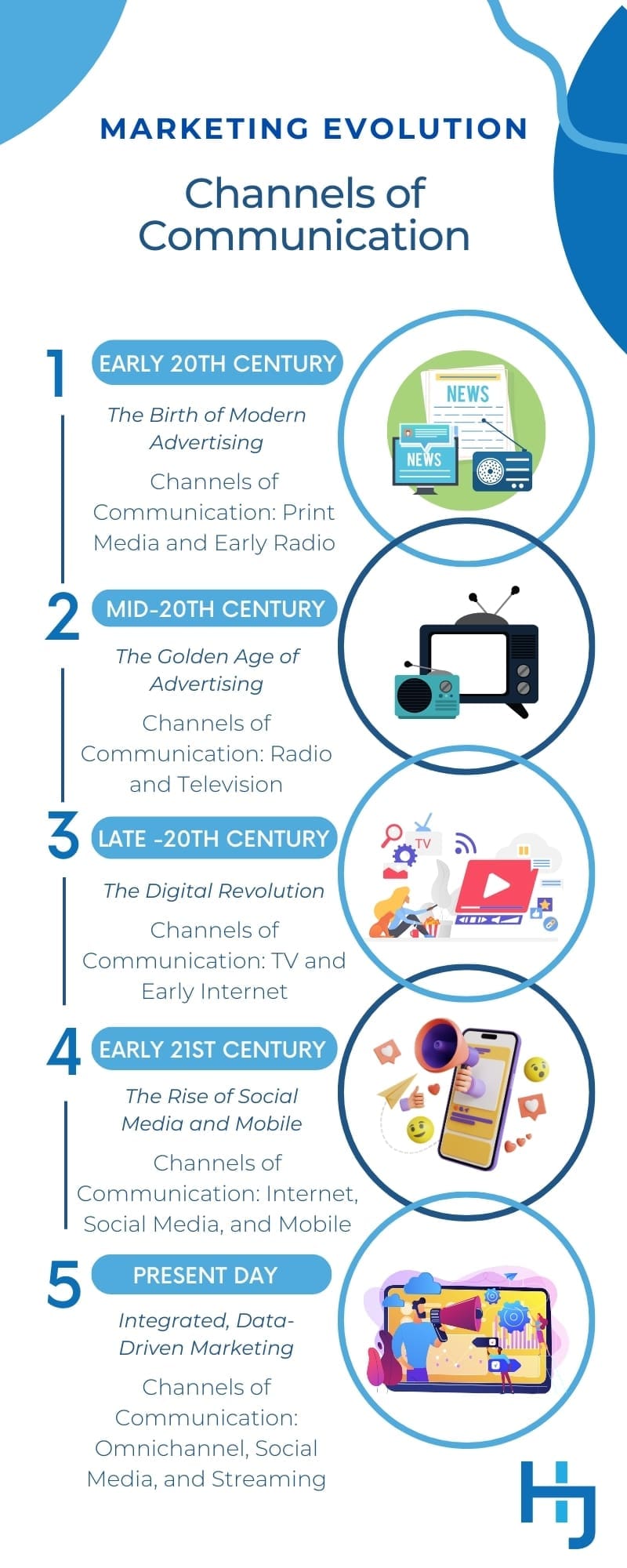 In the 1920s, families gathered around their radios, captivated by the latest advertisements. Fast-forward a century, and now we scroll through targeted ads on our smartphones with the same level of intrigue. How did we get here? Marketing evolution. On this page, I’ll walk you through the history of marketing, advancements and trends that have shaped the industry, and how to integrate lessons of the past into modern marketing strategies to bolster your results.
In the 1920s, families gathered around their radios, captivated by the latest advertisements. Fast-forward a century, and now we scroll through targeted ads on our smartphones with the same level of intrigue. How did we get here? Marketing evolution. On this page, I’ll walk you through the history of marketing, advancements and trends that have shaped the industry, and how to integrate lessons of the past into modern marketing strategies to bolster your results.
Early 20th Century: The Birth of Modern Advertising
Advertising expenditures in the United States were around $200 million in the late 1800s, according to GMU. By the 1920s, they had skyrocketed to $3 billion annually, reflecting the increasing importance of marketing in business strategies.
Channels of Communication: Print Media and Early Radio
In the early 20th century, print media dominated the advertising landscape. Newspapers and magazines were the primary channels through which businesses reached consumers. The first radio advertisement aired in 1922, as We Are Broadcasters reports. This marked the beginning of a new era in advertising. Companies began to recognize the potential of radio as a formidable tool to reach a wide audience.
Consumer Behavior: The Rise of Mass Production and Mass Consumption
The early 1900s saw the rise of mass production, significantly influenced by Henry Ford’s assembly line techniques. This led to an increase in the availability of consumer goods. As products became more affordable, advertising played a crucial role in influencing consumer behavior. Ads often focused on the benefits and modernity of products, encouraging a culture of consumption.
Technological Advancements: Introduction of Radio Advertising
The introduction of radio brought about a revolutionary change in how businesses communicated with potential customers. The first radio commercial, aired by the Queensboro Corporation in New York, demonstrated the medium’s potential to cultivate a direct and immediate connection with audiences. Radio became a staple in homes, offering advertisers a new platform to deliver their messages.
Branding and Storytelling: The Emergence of Brand Mascots and Slogans
The early 20th century marked the beginning of brand mascots and memorable slogans. Brands like Coca-Cola and Campbell’s Soup created mascots and jingles that became household names. This era saw the importance of creating a brand identity that could stand out in the crowded market. Catchy slogans and mascots helped create a lasting impression on consumers.
Examples of Branding and Storytelling in Early 20th Century Marketing
- Coca-Cola: Introduced its iconic contour bottle and “Delicious and Refreshing” slogan, which helped establish a strong brand identity.
- Campbell’s Soup: The “M’m! M’m! Good!” slogan and the introduction of the Campbell Kids mascots made the brand easily recognizable.
Data and Analytics: Early Market Research Methods
While not as sophisticated as today’s methods, early market research began to take shape during this period. Companies started conducting surveys and collecting feedback to better understand consumer preferences and behaviors. This information helped tailor advertising campaigns to meet the desires and needs of the target audience.
Real-World Impact of Early 20th Century Marketing
The success of early radio advertising demonstrated the effectiveness of targeting broad audiences through emerging technologies. For example, the sale of RCA radio equipment surged from $60 million in 1922 to $843 million in 1929 after the introduction of radio ads, per Global Financial Data. This shift highlighted the medium’s commercial potential.
Mid-20th Century: The Golden Age of Advertising
By the end of the 1960s, annual advertising expenditures in the U.S. had reached $19 billion, Galbi Think! reports. This jump reflects the growing importance of sophisticated advertising techniques.
Channels of Communication: Radio and Television

Radio and television became dominant channels for advertising in the mid-20th century. TV, in particular, transformed the marketing landscape. By the 1950s, televisions were common in households, providing advertisers with a powerful medium to reach mass audiences with visual and audio messages. Radio, while still important, began to take a backseat to the growing influence of TV.
Consumer Behavior: Post-War Consumer Boom
Following World War II, there was a significant economic boom. Increased disposable income and the rise of the middle class led to a surge in consumer spending. Advertising capitalized on this by promoting a lifestyle of convenience, modernity, and abundance. Ads focused on new household appliances, cars, and luxury items, appealing to the aspirations of the post-war generation.
Technological Advancements: TV Commercials and Market Research
Television commercials introduced dynamic and visually engaging ways to connect with consumers. Techniques such as product demonstrations, celebrity endorsements, and jingles became popular. Market research also advanced with the development of more systematic approaches to understanding consumer behavior. Techniques like focus groups and surveys became more refined, allowing advertisers to tailor their messages better.
Branding and Storytelling: The Creation of Iconic Brand Campaigns
This era saw the birth of some of the most iconic brand campaigns in advertising history. Brands began to create memorable characters and stories that resonated with audiences. These campaigns were not just about selling products but also about creating a brand image that consumers could relate to and trust.
Examples of Branding and Storytelling in Mid-20th Century Marketing
- Coca-Cola: Continued to innovate with campaigns like “Coke knows no season” and the use of Santa Claus images that became a part of popular culture.
- Pillsbury: Transformed its brand with the “Doughboy” campaign. Within three years, 87 percent of customers recognized Poppin’ Fresh, Pillsbury reports. At the height of his fame, the doughboy received 200 fan letters per week.
Data and Analytics: Early Market Research Methods
The 1950s and 60s saw the rise of more formalized market research methods. Companies like Nielsen began to provide TV ratings, offering advertisers valuable insights into viewership patterns. This data allowed for more targeted and effective advertising campaigns.
Real-World Impact of Mid-20th Century Marketing
The “Think Small” campaign by Volkswagen in 1959 is a classic example of how advertising can influence public perception. It turned the Beetle’s limitations into selling points, focusing on its size, efficiency, and reliability. This campaign is credited with making the Beetle an icon and changing the way cars were marketed.
Late 20th Century: The Digital Revolution Begins
By the late 1990s, marketing expenditures jumped to $222 billion, per Galbi Think! Internet advertising revenue also began carving out a niche, reaching nearly $2 billion in 1998, Internet News reports. This demonstrates the growing importance of digital marketing channels.
Channels of Communication: TV and Early Internet
In the late 20th century, television continued to be a dominant advertising medium, but the rise of the Internet began to revolutionize the marketing landscape. By the mid-1990s, the Internet was becoming more accessible to the general public, opening up new channels for digital advertising. Email marketing emerged as one of the first forms of Internet-based advertising.
Consumer Behavior: More Targeted Marketing
As the Internet grew, consumers began to seek more personalized and relevant content. This shift led to the early stages of targeted marketing, where advertisers could start to tailor their messages based on consumer interests and behaviors. The ability to track user interactions online provided new insights into consumer preferences.
Technological Advancements: Personal Computers and Email Marketing
The proliferation of personal computers in households and workplaces created new opportunities for marketers. For instance, email marketing became a powerful tool, allowing businesses to reach consumers directly in their inboxes. The late 1990s saw the advent of search engines like Google, which would later transform digital advertising with the introduction of search ads and pay-per-click (PPC) models.
Examples of Technology in Late 20th Century Marketing
- Hotmail: One of the earliest examples of viral marketing. Hotmail included a simple tagline at the bottom of each email sent by its users, which encouraged recipients to sign up for the service. This strategy rapidly increased its user base.
- Amazon: Launched in 1995, Amazon leveraged the Internet to create a new kind of retail experience, using email marketing to promote products and engage customers.
Branding and Storytelling: Introduction of Direct Marketing
The late 20th century saw a shift towards direct marketing, where brands aimed to establish more direct and personalized relationships with consumers. Catalogs, direct mail, and telemarketing were widely used techniques. Brands began to focus on building loyalty through personalized messages and offers.
Example of Branding and Storytelling in Late 20th Century Marketing
- L.L.Bean: Known for its comprehensive catalogs, L.L.Bean effectively used direct mail to reach its customers, providing detailed product information and personalized offers.
Data and Analytics: The Beginning of Digital Data Collection
With the rise of the Internet, data collection became more sophisticated. Web analytics tools emerged, allowing businesses to track user behavior on their websites. Metrics like page views, click-through rates, and conversion rates became essential for measuring the effectiveness of digital campaigns.
Real-World Impact of Late 20th Century Marketing
The launch of Google AdWords in 2000 (just before the turn of the century) marked a significant shift in advertising. It introduced a pay-per-click model that allowed businesses of all sizes to advertise online, democratizing access to digital marketing.
Early 21st Century: The Rise of Social Media and Mobile
Reflecting the continued shift towards digital marketing, Internet advertising revenue in the U.S. reached nearly $27 billion in 2010, per pWc.
Channels of Communication: Internet, Social Media, and Mobile

The early 21st century witnessed the explosive growth of the Internet, social media, and mobile technology. The Internet became the primary channel for marketing, with social media platforms like Facebook (founded in 2004), YouTube (2005), Twitter (2006), and Instagram (2010) revolutionizing how brands interact with consumers. Mobile devices, particularly smartphones, became ubiquitous, enabling marketers to reach consumers anytime and anywhere.
Consumer Behavior: Shift Towards Digital Consumption
Consumers increasingly turned to digital channels for information, entertainment, and shopping. This shift led to the rise of e-commerce and the expectation of instant access to products and services. Consumers began to seek more personalized and interactive experiences, prompting brands to adapt their strategies to meet these demands.
Technological Advancements: Social Media Platforms and Smartphones
The rapid advancement of social media platforms provided new ways for brands to engage with their audiences through content sharing, social interactions, and targeted advertising. Smartphones, with their widespread adoption, enabled location-based marketing and mobile apps, creating opportunities for real-time engagement with consumers.
Examples of Early 21st Century Technological Advancements
- Facebook Ads: Launched in 2007, Facebook’s advertising platform allowed businesses to target users based on their interests, behaviors, and demographics, revolutionizing digital advertising.
- Apple’s App Store: Opened in 2008, the App Store enabled businesses to reach consumers through mobile apps, creating new opportunities for engagement and monetization.
Branding and Storytelling: User-Generated Content and Influencer Marketing
Brands began to leverage user-generated content (UGC) and influencer marketing to build trust and authenticity. Consumers were no longer just passive recipients of marketing messages; they became active participants in brand conversations. Influencers, with their large and engaged followings, became powerful allies for brands looking to reach niche audiences.
Examples of Early 21st Century Branding and Storytelling
- GoPro: Leveraged UGC by encouraging customers to share their videos and photos taken with GoPro cameras, creating a community-driven brand narrative.
- Nike: Collaborated with influencers and athletes to promote its products, enhancing its brand credibility and reach.
Data and Analytics: Advanced Web Analytics, Big Data
The early 21st century saw significant advancements in web analytics and the use of big data. Tools like Google Analytics (launched in 2005) provided businesses with detailed insights into website traffic, user behavior, and conversion rates. The ability to collect and analyze large volumes of data allowed marketers to make data-driven decisions and optimize their campaigns for better performance.
Real-World Impact of Early 21st Century Marketing
The success of Old Spice’s “The Man Your Man Could Smell Like” campaign in 2010 demonstrated the power of social media and viral marketing. The campaign’s humorous and engaging videos led to a significant increase in online engagement and sales, showcasing the effectiveness of creative and interactive content.
Present Day: Integrated, Data-Driven Marketing
Today, global digital advertising spend is estimated to exceed $667 billion, per WordStream. This underscores the dominance of digital channels in marketing strategies.
Channels of Communication: Omnichannel, Social Media, and Streaming
In the present day, marketing channels are more diverse and integrated than ever before. Omnichannel marketing, which ensures customers have a experience across various channels (online and offline), has become essential. Social media networks continue to evolve, with newer entrants like TikTok gaining significant popularity. Streaming services like Netflix, Hulu, and Spotify also offer new advertising opportunities, providing brands with a way to reach audiences with highly targeted and personalized content.
Consumer Behavior: Personalized Experiences
Today’s consumers expect personalized experiences tailored to their preferences and behaviors. They seek authenticity and value from brands, preferring those that align with their values and offer meaningful interactions. The rise of ad-blockers and the growing concern over privacy have also pushed brands to adopt more transparent and respectful marketing practices.
Technological Advancements: AI, Machine Learning, and AR/VR
Advanced technologies like artificial intelligence (AI), machine learning, and augmented/virtual reality (AR/VR) are transforming marketing strategies. AI and machine learning enable predictive analytics, personalized recommendations, and chatbots for customer service. AR/VR create immersive experiences, allowing consumers to interact with products in innovative ways.
Examples of Present-Day Technological Advancements
- Netflix: Uses AI and machine learning to provide personalized content recommendations, keeping users engaged and subscribed.
- IKEA Place App: Utilizes AR technology to let users visualize how furniture would look in their homes, enhancing the shopping experience.
Branding and Storytelling: Authenticity, Purpose-Driven Brands
Modern branding emphasizes authenticity and purpose. Consumers gravitate towards brands that are genuine, transparent, and socially responsible. Purpose-driven brands that stand for something larger than their products, such as sustainability or social justice, tend to build stronger emotional connections with their audiences.
Examples of Present-Day Branding and Storytelling
- Patagonia: Known for its commitment to environmental sustainability, Patagonia’s campaigns emphasize its mission to protect the planet, resonating with eco-conscious consumers.
- Nike: Continues to align itself with social causes, as seen in its campaigns supporting racial equality and social justice, which have bolstered its brand image.
Data and Analytics: Real-Time Analytics and Predictive Analytics
Data analytics has reached new heights with real-time and predictive capabilities. Marketers can now track and analyze consumer behavior in real-time, allowing for immediate adjustments to campaigns. Predictive analytics uses historical data and AI to forecast future trends and consumer actions, enabling more proactive and effective marketing strategies.
Real-World Impact of Present-Day Marketing
The success of Spotify’s Wrapped campaign showcases the power of personalization and data analytics. By providing users with a personalized summary of their listening habits, Spotify creates a highly engaging and shareable experience, strengthening user loyalty and generating extensive social media buzz.
Integrating Past Lessons into Future Strategies
The evolution of marketing over the past century provides invaluable lessons that can be integrated into future strategies. By understanding the successes and challenges of the past, marketers can develop more effective, innovative, and sustainable approaches. Below, we’ll review some key lessons from each era and how they can be applied to future strategies.
The Power of Storytelling and Branding

From the early 20th century’s use of mascots and slogans to the iconic campaigns of the mid-20th century, storytelling has always been a powerful tool in marketing. Brands that create compelling narratives and strong identities tend to resonate deeply with consumers.
Storytelling and Branding Strategies of the Future
Invest in storytelling that is authentic and aligns with your brand’s values. Use multimedia content to create engaging narratives that can be shared across various channels. Personalize these stories to different segments of your audience to create a more intimate connection.
Example of the Power of Storytelling and Branding
Apple’s consistent storytelling about innovation and simplicity, from the early “Think Different” campaign to recent ads focusing on privacy and sustainability.
Embracing Technological Advancements
Technological innovations like radio, television, the Internet, and social media have repeatedly transformed marketing. The late 20th century’s digital revolution and the present-day advancements in AI and AR/VR show that technology drives marketing evolution.
Martech Strategies of the Future
Stay ahead by adopting new technologies early. Use AI for predictive analytics and personalized marketing. Explore AR/VR for immersive brand experiences. Continuously test and optimize new tools and platforms to find what works best for your brand.
Example of Embracing Technological Advancements
Sephora uses AR in its Virtual Artist app to allow customers to try makeup on virtually, enhancing the shopping experience and increasing engagement.
Data-Driven Decision Making
The progression from early market research to advanced web analytics highlights the importance of data in marketing. Real-time and predictive analytics are crucial for understanding consumer behavior and optimizing campaigns.
Data-Driven Decision-Making Strategies of the Future
Build robust data analytics capabilities to track and analyze consumer interactions in real time. Use this data to make informed decisions and personalize the customer experience. Ensure data privacy and transparency to build trust with consumers.
Example of Data-Driven Decision Making
Netflix’s recommendation engine uses data analytics to personalize content suggestions, leading to higher viewer satisfaction and retention.
Consumer-Centric Approach
The shift from mass marketing to more targeted, personalized approaches reflects the growing importance of understanding and meeting consumer needs. The rise of social media and user-generated content emphasizes the value of consumer engagement and feedback.
Consumer-Centric Strategies of the Future
Prioritize a consumer-centric approach in all marketing efforts. Use social listening tools to gather insights and engage with your audience directly. Create platforms for user-generated content and leverage influencer partnerships to build trust and authenticity.
Example of Consumer-Centric Approaches
Starbucks’ use of social media to engage with customers, gather feedback, and promote user-generated content strengthens community ties and brand loyalty.
Integration and Omnichannel Strategies
The transition to omnichannel marketing in the present day shows the importance of providing a seamless and consistent experience across all touchpoints. Integrated marketing ensures that all channels work together to reinforce the brand message.
Integration and Omnichannel Strategies of the Future
Develop an integrated marketing strategy that aligns all channels and touchpoints. Ensure that your branding, messaging, and customer experience are consistent whether consumers interact with your brand online, in-store, or through mobile devices. Use omnichannel analytics to understand the customer journey and optimize each touchpoint.
Example of Integration and Omnichannel Strategies
Disney’s omnichannel strategy, which integrates its website, mobile apps, theme parks, and retail stores to create a seamless and engaging customer experience.

Be Prepared for the Evolution of Marketing
As a digital marketing consultant with decades of experience in the field, I’ve watched digital marketing evolve from the start. While not all trends have staying power or shape the future of digital marketing, I believe it’s essential for brands to take a measured approach and experiment with new trends and technologies as their effectiveness becomes proven. If your business isn’t sure how to leverage modern marketing tools and technologies or fold them into your current operations, I can help. Contact me for a complimentary consultation.
Marketing Evolution FAQs
What are the key differences between traditional and digital marketing?
Traditional marketing uses channels like TV, radio, and print, focusing on broad audience reach. Digital marketing leverages online platforms, social media, and mobile apps, offering precise targeting, real-time analytics, and interactive engagement, making it more adaptable and cost-effective.
Why is storytelling important in modern marketing?
Storytelling creates emotional connections, making brands memorable and relatable. It helps convey values and build trust, encouraging consumer loyalty. Effective storytelling engages audiences, differentiates brands, and enhances the overall customer experience, driving deeper engagement and conversions.
How has social media changed the marketing landscape?
Social media has revolutionized marketing by enabling direct, real-time engagement with consumers. It allows brands to create personalized content, leverage influencer partnerships, and gather instant feedback. Social media platforms also provide powerful targeting and analytics tools, enhancing campaign effectiveness.
What role does data analytics play in contemporary marketing strategies?
Data analytics provides insights into consumer behavior, preferences, and trends, enabling personalized marketing. It helps measure campaign performance, optimize strategies, and predict future trends. By leveraging data, marketers can make informed decisions, improving efficiency and ROI.
How can businesses integrate past marketing lessons into their future strategies?
Businesses can integrate past lessons by embracing storytelling, adopting new technologies early, leveraging data analytics, focusing on consumer-centric approaches, and ensuring omnichannel integration. Learning from historical successes and failures helps create more effective and innovative marketing strategies.
What are the most effective channels for digital marketing today?
Brands benefit from a variety of digital marketing tactics. By following the “Digital Marketing Tree” approach, a business can deploy channels and tactics strategically, ensuring maximum return while gradually folding in additional techniques.
How has consumer behavior influenced marketing strategies over the years?
Consumer behavior has driven the shift from mass marketing to personalized, targeted campaigns. The demand for convenience, authenticity, and engagement has led to the rise of digital and social media marketing, requiring brands to be more responsive and consumer-focused.
What technological advancements have had the biggest impact on marketing?
The Internet, social media platforms, smartphones, AI, machine learning, and AR/VR have significantly impacted marketing. These technologies enable precise targeting, real-time engagement, personalized experiences, and innovative advertising formats, transforming how brands connect with consumers
Why is personalization important in today’s marketing efforts?
Personalization enhances the consumer experience by delivering relevant, tailored content. It increases engagement, builds loyalty, and improves conversion rates. In an era of information overload, personalized marketing helps brands stand out and meet individual consumer needs effectively.





































































